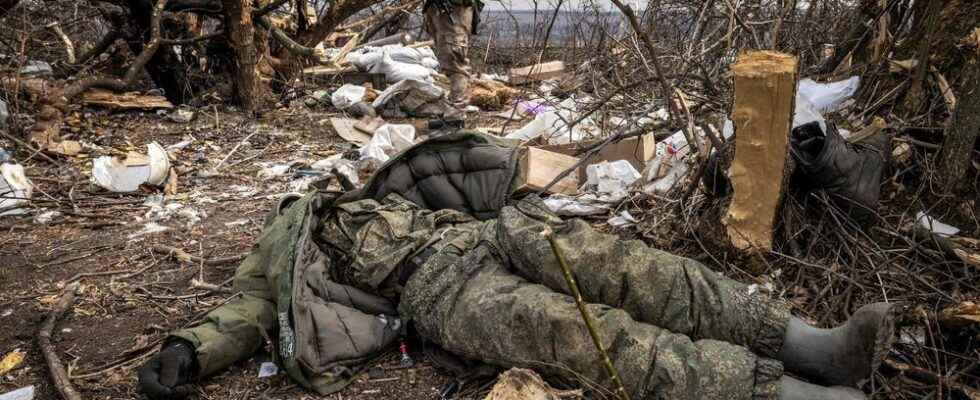In appearance, Moscow has regained the hair of the beast. “The Russians are continuing their assault and consolidating their positions in the center of Severodonetsk,” regional governor Serguii Gaïdaï said on Wednesday morning, after indicating the day before that they now controlled “most of it”. This industrial city – which is one of the great Ukrainian strongholds in the Donbass – is currently at the center of Russian efforts to seize the region of Lugansk, coveted, like that of Donetsk, by Moscow. If its fall seems inevitable today, it should not however mask a lasting weakening of the Russian forces after more than three months of grueling conflict.
“It is clear that Russia’s offensive on Ukraine is not going well, confirms Mathieu Boulègue, researcher specializing in Eurasia at Chatham House, a London think tank. And after nearly 100 days of conflict, the Russian forces appear to be severely degraded.” In its daily report published on Wednesday June 1, kyiv announced that 30,700 Russian soldiers had been killed since the start of the invasion on February 24. While this figure is impossible to independently verify, the British Ministry of Defense estimated on May 23 that at least 15,000 Russian fighters had died in Ukraine, as many as the number of Soviet soldiers killed in Afghanistan in 9 years of war in the 1980s. A figure to which must be added thousands of wounded, missing or detained by Ukrainian forces.
A Ukrainian soldier walks past the body of a Russian soldier in the village of Mala Rogan, east of Kharkiv, on March 30, 2022, Ukraine
AFP/Fadel Senna
Losses that will weaken Russia for a long time. “In the 2000s, it had bet on a professionalization of its army, that is to say fewer soldiers, but with a higher level of skill and technical mastery. Yet it is precisely this personnel qualified, and long to replace, which it is losing in Ukraine”, underlines Vincent Tourret, researcher specializing in military issues at the Foundation for Strategic Research (FRS). As a sign of Moscow’s difficulties in filling the troops, Putin signed a law on May 28 extending the age limit for enlisting in the army from 40 to 50 years, also paving the way for active service for men. up to 65 years old.
Heavy material losses
Beyond its human resources, a significant part of Russian military equipment has also been swallowed up in the war effort. On May 26, the Pentagon estimated that Russia had lost nearly 1,000 tanks, 350 artillery pieces, more than 50 helicopters and around 30 fighter bombers. “Russia still has a large stock of armored vehicles inherited from the Soviet era, however its most modern equipment such as the T-72B3M tanks have suffered heavy losses. And this is a real difficulty”, notes Vincent Tourret. According to the Ukrainian general staff, old Soviet T-62 tanks – whose design dates back to the 1960s – were remobilized at the end of May to equip Russian reserve forces.
At the same time, Russia’s ability to replenish its lost armor stocks in Ukraine has been seriously undermined by US and European sanctions. Due to a lack of Western components, the two main Russian tank manufacturers – Uralvagonzavod Corporation and Chelyabinsk Tractor Plant – had to stop their activity in March. A shortage that has led Moscow to seek unorthodox solutions… “We have reports from Ukrainians who say that when they find Russian military equipment on the ground, it is full of semiconductors that have been removed from dishwashers and refrigerators,” U.S. Commerce Secretary Gina Raimondo said in a Senate hearing on May 11.
“The new wave of sanctions further weakens the Russian military-industrial complex, which had already been hit significantly following those taken in 2014, after the annexation of Crimea, underlines Mathieu Boulègue. Russia can always turn to China, but this risks resulting in a drop in the quality of its equipment in addition to increasing its dependence on Beijing.”
Missiles are also beginning to run out in the Russian arsenal. On May 2, the Pentagon said that Moscow had fired no less than 2,125, which is estimated to be more than two-thirds of its reserves. And, here again, Western sanctions will weigh heavily on Russia’s ability to renew its stocks. “Russia wanted during the decade 2020-2030 to build an army equipped with a new range of armaments and to be able to wage high-tech warfare. But all these developments are now out of reach, summarizes Vincent Tourret. Russian army will take years to recover from this conflict, if only to return to the capabilities it had before the start of its offensive.”
